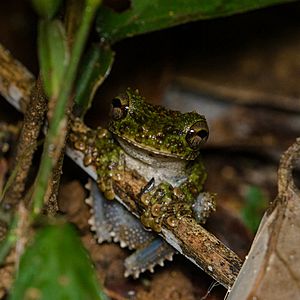Osteocephalus cabrerai facts for kids
Quick facts for kids Osteocephalus cabrerai |
|
|---|---|
 |
|
| Conservation status | |
| Scientific classification | |
| Synonyms | |
|
Hyla cabrerai Cochran and Goin, 1970 |
The Osteocephalus cabrerai is a type of frog that belongs to the Hylidae family, also known as tree frogs. This frog lives in the amazing Amazon Basin. You can find it in countries like Brazil (near Manaus), northeastern Peru, Ecuador (in Sucumbíos and Orellana areas), Colombia (in Amazonas, Caquetá, and Vaupés areas), Guyana, and French Guiana. It might even live in more places!
Some older records about this frog actually referred to a different species called Osteocephalus buckleyi.
Contents
About the Name
Why is it called cabrerai?
The special name cabrerai was given to this frog to honor a Colombian naturalist and collector named Mr. Isodore Cabrera. A naturalist is someone who studies nature, like plants and animals.
What Does It Look Like?
Size and Skin
Adult male Osteocephalus cabrerai frogs can grow up to about 55 millimeters (which is about 2.2 inches) long. Female frogs are a bit bigger, reaching up to 71 millimeters (about 2.8 inches) from their snout to their rear.
Their snout (the front part of their head) is flat. They have a very clear, oval-shaped eardrum, called a tympanum. There's also a bumpy fold of skin above their eardrum.
The skin on their back is different for males and females. Females have bumpy skin, while males have even bumpier skin. These bumps on males do not have hard, pointy tips like another frog, Osteocephalus buckleyi. The skin on their sides is covered in small, rounded bumps.
Feet and Color
Their fingers are about half-webbed, which means there's skin between them for about half their length. Their toes are fully webbed, with the webbing reaching almost to the end of their fourth toe.
The color of their back can change a lot! It can be different shades of green with tan and brown spots, stripes, or a net-like pattern. Their sides are usually light-colored and might have tan spots. Their belly is a creamy white, sometimes with tan spots.
They also have a light mark that goes from their eye down towards the middle of their eardrum. Male frogs have two vocal sacs, which they use to make calls and attract mates.
Where It Lives and How We Protect It
Habitat
The Osteocephalus cabrerai frog lives in lowland tropical rainforests. These are warm, wet forests found in lower areas. People have seen these frogs on low plants in untouched forests or at the edge of forests, especially at night.
Conservation
This frog is not very common. It faces threats in some places because its habitat is being destroyed. This happens when forests are cut down for farming, logging, or building.
However, this frog lives in several protected areas. These are special places where nature is kept safe from harm, which helps protect the Osteocephalus cabrerai and other animals that live there.
See also
 In Spanish: Rana de casco de Cabrera para niños
In Spanish: Rana de casco de Cabrera para niños


